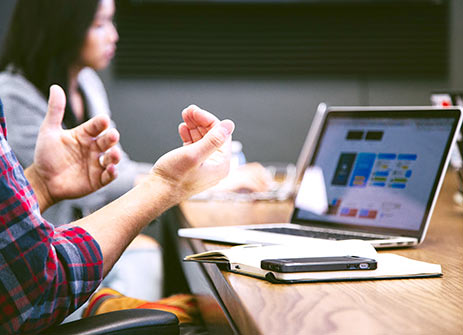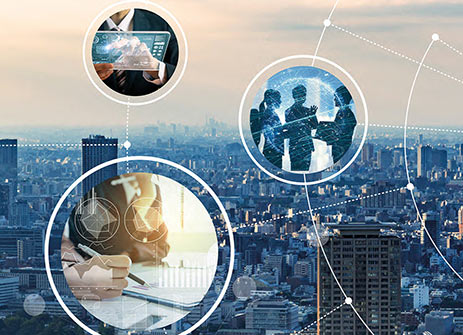We've developed an approach to help teams get real value from their experiences during these times.
The lessons learned in teams over the last few weeks are made tangible and transparent to all. Hypotheses are then formed together and assumptions are tested.
This evaluation forms the basis for making decisions:
- What should remain in the future as it was performed during the crisis.
- What will be abolished.
- What will be retained, as it was before the crisis, because it has proven itself or because it may change.
Monika Dimitrakopoulos-Gratz:
We are already slowly getting used to the new normal. We work from home and communicate virtually. One video conference follows another and with a click we get to the next meeting. Where there used to be a few minutes' walk in between to get from one meeting room to another, all it takes is a new dial-in.
Many people I have spoken to in recent days report that this form of exchange works surprisingly well. At the same time, the vast majority of experiences that virtual conferencing via video takes an enormous amount of energy, and at the end of the day you find yourself exhausted on the sofa and wondering how that can be.
What is so different? Our brain is adjusting.
The quality of attention and the way we relate to people changes when we communicate via video conferencing. The way of connecting and collaborating is new for many and especially unfamiliar at the current frequency we are doing it. The reports and an experience from the last few weeks coincide. On the one hand is the fact that it comes to very intensive connections and many seamless conversations. We show more of ourselves as people and become more authentic. The function recedes into the background and we perceive each other much more as people. This is a wonderful experience that will have an impact on communication in everyday professional life after Corona. On the other hand, we experience that we are electronically connected but physically separated from each other. And that is exhausting in the long run. In electronic exchanges, the brain is particularly challenged. First of all, it is not designed to spend so much time in front of the screen. Therefore, it automatically switches to another mode.
Thus, as soon as we look into our screen, our eye recognizes that it is artificial light we are looking into. And the human brain performs an even more crucial service. It is smart and can immediately distinguish whether we are in real contact with others or whether we are virtually connected.
So it focuses on the few sensory impressions there are to grab. Where body language, gestures and facial expressions could be quickly captured as an overall impression in a direct exchange, only a limited section remains online. Technical problems and a poor Internet connection make things even more difficult. Who hasn't experienced the face of the person speaking freezing? We can only guess what will happen emotionally in the next few seconds. We are missing an important piece of the puzzle and the brain is trying at high pressure to complete the picture. That costs energy.
So as soon as we meet with several people via videoconference, we have to deal with and sort out many new impressions. Which of the many faces do I look at? Who am I listening to? What is that cat doing in the background? When does the screaming of the children in the background end? Where did that colleague get that sweater? So we're dealing with an information overload of a completely different nature that we're not so familiar with from our usual face-to-face meetings. Everything that we haven't rehearsed and our bodies and minds aren't used to increases energy consumption. And the more we deal with all these impressions, the less we can focus on the other person, i.e. the person and his needs. We are connected and disconnected at the same time. Perhaps this is what leads us to this exhaustion at the end of an online meeting marathon?
In the virtual space, a somewhat paradoxical situation arises: we feel connected and separated at the same time.
Another experience from online meetings is that we are many times more easily distracted. Yes, we even feel freer in the virtual meeting in a certain way, because we are more unobserved. We can briefly turn off the sound and camera and do something else. But even when the sound and camera are on, I've found myself much more quickly checking emails on the side, popping over to LinkedIn or Twitter, or doing other tasks. In any case, I don't know this behavior from face-to-face meetings. The temptation to take time out in between seems greater. We can then call these moments “multitasking” moments. We have already experienced before Corona how this can negatively affect our productivity and how much more draining this is.
I'd like to share here a few very simple and effective methods that I've tried myself and that have evolved from numerous conversations with clients and colleagues. These tips are intended to help shape this newly normal exchange in a way that maximizes connection, and allows us to return to work from the virtual space invigorated and energized.
Tip 1
Set focus: Reserve 1 minute before you start to arrive by yourself. Stand up briefly or take a few deep breaths while seated to turn your own attention and focus inward. Then think: What is my contribution to the meeting? What experience, expertise and information can I bring?
Tip 2
Make a connection: Once you've entered the meeting room, get an overview of who's there. Greet each participant with a smile and connect with them by making brief eye contact.
Tip 3
Be visible: Keep your video turned on so that others have the opportunity to see you.
Tip 4
Don't multitask: Resist attempts to multitask and close all applications in the background that are not immediately necessary for the meeting. (Email, internet, intranet, various apps).
Tip 5
Take breaks: Human attention spans are shorter than we often think they are, already after 20 min. the concentration decreases. And that's why it's important to schedule a break of 5-10 min. after 50 min. at the latest during longer meetings. This promotes the regeneration of mind and body. Afterwards, we are back at work with renewed attention.
Whether we want to or not. Virtual collaboration becomes the new normality. Perhaps not with the intensity that is taking place in the corona crisis. Fortunately, we humans have the gift of responding quickly to change. The learning curve for all of us has been enormous over the past few weeks. It requires everyone, in addition to learning the technical intricacies, to be careful with each other and to pay attention to our energy. Let's take advantage of this opportunity, try things out and learn new things together when dealing with virtual collaboration.
Learning from crisis - an approach for teams
We have developed an approach to help teams get real value from their experiences during these times. Learning from Crisis for Teams.
The experiences made in the teams during the last weeks are made tangible and transparent for all. Hypotheses are then formed together and assumptions are tested.
This evaluation forms the basis for making decisions:
• What practices are to be continued post lockdown.
• What will be abolished.
• What will be kept, as it was before the crisis, because it has proven itself or because it may change.
XING https://www.xing.com/home/stories/4314641054
Not all storms come to disrupt your life, some come to clear your path.
Corona Retro - Learning from the crisis II
Wonderful, encouraging experiences!
We have implemented our approach with different customers and in different industries.
Important elements here are:
- An internal team or a larger department
- An interview guide
- The desire to listen
- Curiosity to think ahead together
Procedure
An internal team of people who have the desire and can spare the time conducts interviews according to a common guide. The focus of the questions is on perceptions of differences between the pre-lockdown period and current times when things are becoming more open again. In doing so, 3 perspectives are highlighted:
- internal cooperation
- contacts with customers
- new trends, ideas, changes in the environment, in our society.
The results of the interviews are transparent for all, are sorted together, reflected and new things are tried out and reflected again.
Small things are often realized during the interview phase - such as collective online spaces without purpose, (campfire), as an alternative to the coffee kitchen.
Of course, the findings first concern the difference between home office versus “going into work”. It becomes clear that almost everywhere the new free time allocation in the home office is experienced as surprisingly positive, even if there was previous experience with home office.
The balance that everyone has to find for themselves, be it children and job, be it their own needs and job, is, when found, a great asset.
Praise be to those employers who give their home office employees this opportunity and rely on trust rather than control.
Thinking further, this means no longer thinking of work in terms of working hours and places “I go to work” versus “I stay at home,”but rather in terms of the qualities and necessities of individual activities.
So for what kind of work do I need what kind of environment?
- For which work steps do I need quiet to be able to concentrate?
- For which work steps do I need to exchange questions and conversation?
And cultivating a good sense of when it's time to change locations.
The next insight space concerns the difference of virtual meetings versus in person meetings.
More on that in the next blog




